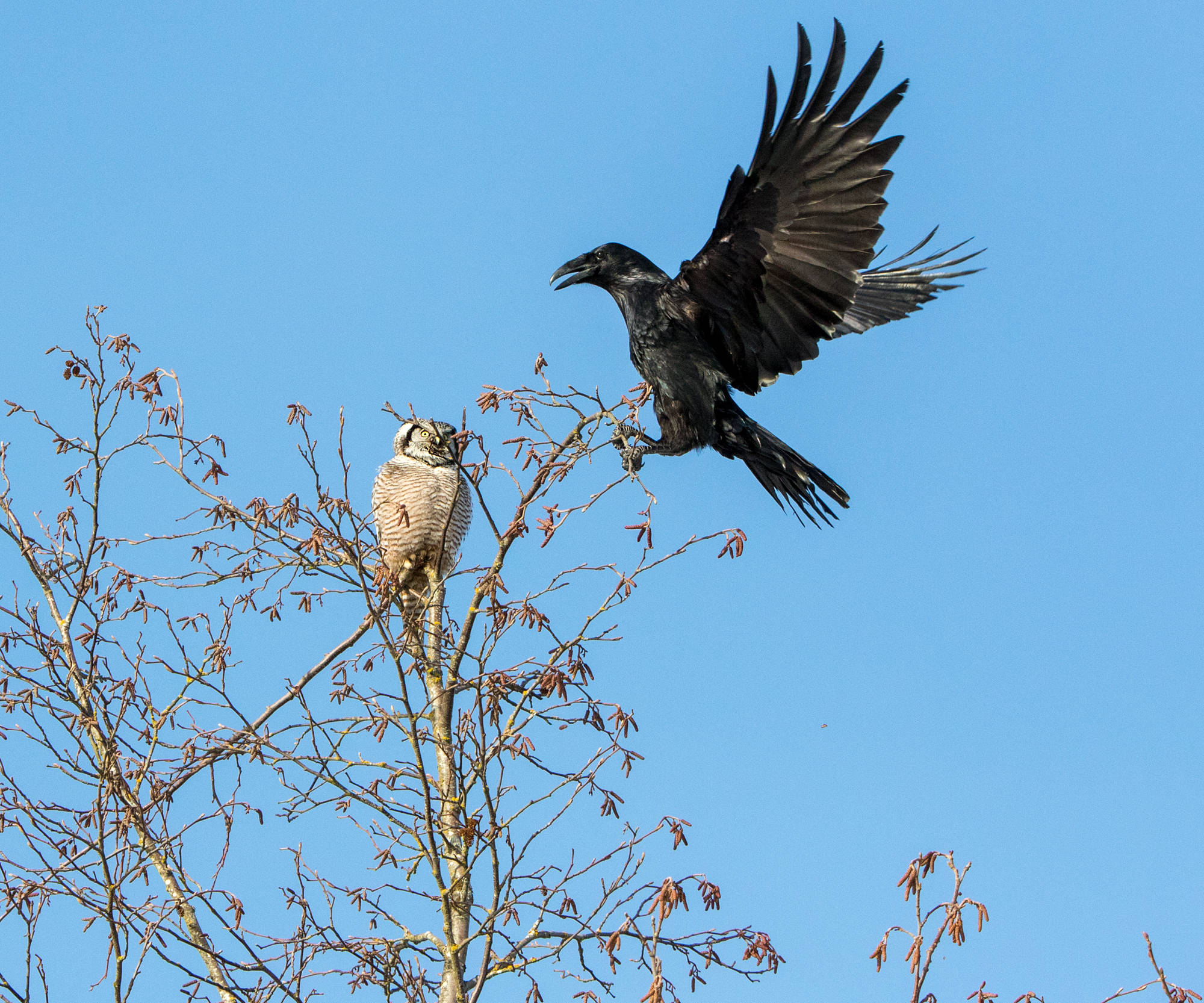The northern hawk owl that has often been seen this winter, out at the edges of the wetlands, is a solitary hunter. It usually preys on small mammals, but it is also reported to capture birds, even some that outweigh it, such as grouse. It commonly hunts in daylight, but although it does not have the specialized, asymmetrical ears of the very nocturnal owls, its hearing is acute and it can forage at night too.
Hawk owls typically perch on top of trees and shrubs while they are scanning the landscape for prey. There they are fairly conspicuous, attracting the attentions of many, mostly benign, observers. They often attract some not-so-benign, unwanted attention, as well: other birds that persistently harass them as they perch peacefully on their high lookouts. Several observers noted that the hawk owl on the wetlands was pestered by ravens, crows, magpies and a shrike.
When birds harass an owl or another raptor, they often fly at it, veering away sharply or occasionally even striking it, call loudly, and maybe defecate on it. Sometimes additional birds are called in to join what is known as mobbing behavior. In some cases, dozens of mobbing birds, of one or more species, gather to pester a single owl. Even if the owl is just trying to have a nice nap, the mobbers may move in.
Why do birds mob other birds, especially predators, but occasionally even members of the same species? It might be a risky business, if the victim decides to retaliate. And there is a cost in energy expenditure. There can be several motivations, depending on the circumstances.
Mobbing of predators is most often observed during the breeding season, when nesting birds of many species defend their nestlings and fledglings from potential danger. The mobbers may actually bother a predator sufficiently to make it move elsewhere. Or perhaps their frenzied attacks distract a predator, keeping it from focusing on nest and chick locations.
Sometimes mobbing is a means of stealing food from another critter. (In another but similar domain, a flock of ravens is enough to keep a pack of wolves off their deer or moose carcass while the ravens gorge themselves.) And we have seen two or three magpies tormenting an eagle — one tweaking the eagle’s tail to distract it while the other(s) grab a chunk of fish.
Mobbing behavior by gangs of a single species may also have social functions. Adults might demonstrate that behavior to their juveniles, teaching them what other birds are potentially dangerous and what to do about it. They might also practice their own skills or invent new techniques to pass on to the young ones.
Mobbing by a single-species gang also provides opportunities for showing off, to peers, for instance. Group members learn who is bold and who is timid, who is willing to assist a direct attack and who waits for somebody else to take the risk of getting close to a bird that might retaliate. If the risk is not excessive, the risk-takers might acquire status within the group, gaining better access to resources or, eventually, to mates.
Or perhaps the risk-takers are showing off to potential mates, impressing them with a display of energy, agility, and daring. A recent study reported some fascinating experiments with birds in Brazil. The researchers put out models of two kinds of owls, one a known regular predator of birds and the other one less dangerous insect-eater. When birds gathered to harass the models, males mobbed more than females. Males also became more active when females were numerous, as if they wanted to impress the ladies. Those males were careful, though, taking account of the level of risk: they more actively attacked the model that was less dangerous! (I have not learned if that activity actually paid off when it was time to mate, however.)
Working together to harass a predator might also build social cohesion. The participating birds would learn more about each other and what roles each member would play. And thus the group might become more effective in discouraging a predator or sharing a food source.
And in the case of ravens, and perhaps crows and magpies too, I would not put it past them just to be having fun.
Clearly, only a few of these possible functions of mobbing behavior seem likely to pertain to this particular hawk owl on the wetlands. It’s not the breeding season, the hawk owl didn’t have food to steal, not all the attackers were in groups of the same species, and so on. Readers can make up their own minds about the most likely motivations in this case.
Birds are not the only animals that mob. Even some fishes are said to gang up on animals that annoy them. But the best examples come from mammals, from meerkats to monkeys and other primates. Go to the neotropical rainforest and walk about in the understory; eventually the howler monkeys are likely to gather in the trees above you, making a racket and hurling feces at you. Humans are notorious mobbers, notably against other humans, with various social motivations. I leave it to readers to make the parallels with the bird behaviors noted here.
• Mary F. Willson is a retired professor of ecology. “On The Trails” appears every Friday. Her essays can be found online at onthetrailsjuneau.wordpress.com.

